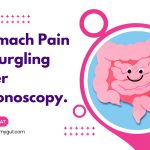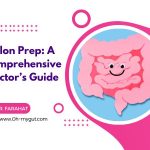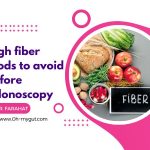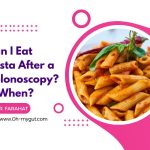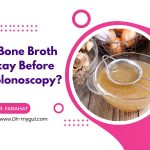Pain After Colonoscopy Polyp removal: 5 Causes, Gastroenterologist Explains
Our content is not intended nor recommended as a substitute for medical advice by your doctor. Use for informational purposes only.
Up to 45% of patients undergoing colonoscopy report pain after the procedure (reference). And you are more likely to have pain if you’ve got a polyp removed during a colonoscopy.
The majority of the causes are minor. However, major complications can develop after colonoscopic polyp removal.
Causes of pain a week after colonoscopy include:
- Trapped gas inside your abdomen.
- Prolonged colonoscopy procedure.
- Post-polypectomy coagulation syndrome.
- Colon preparation after effects.
- Immediate or delayed colon perforation.
- Bacterial infection.
- Rare causes: splenic injury or rupture, acute appendicitis, diverticulitis, intra-abdominal bleeding, and colitis from the disinfectant material.
1. Trapped gas inside the colon after colonoscopy.
During a colonoscopy, your doctor inflates your colon with air (making it like a balloon). This is essential to your colonoscopy to help visualize and remove the colon polyps.
At the end of the colonoscopy, your doctor tries to deflate the colon via air suction. However, the suction is usually not complete.
According to some studies, minor abdominal pain, discomfort from trapped gas, and prolonged manipulations affect 7% of patients. (reference).
This is especially more common for colonoscopy with polyp removal. This is because polyp removal via colonoscopy usually takes a long time and more manipulation.
Characters post-colonoscopy gas pain:
- The pain starts immediately after your recover from the colonoscopy anesthesia.
- You may feel pain for several hours up to a few days.
- The pain gets better with time.
- It is in the form of colics (waves of contractions).
- The cramps are often associated with distension and bloating.
- No severe tenderness on touching the abdomen.
- The pain partially improves after passing gas (flatus).
Always ask your doctor about the pain after polyp removal if you are unsure about its cause.
Gas pain is unlike pain from major complications. Major complications such as perforation cause intolerable and are associated with severe tenderness all over your abdomen.
Tips to improve gas pain:
- Before the procedure, ask your doctor to use Carbon dioxide gas(if available) instead of normal air. It is absorbed rapidly into the blood and causes less distension.
- Immediately after colonoscopy, roll out from the left lateral to the right lateral position. This allows easier passage of gas to the outside.
- Early walking and moving after a colonoscopy also help.
- Avoid Excess gas-producing high-fiber foods and legumes such as vegetables, beans, popcorn, and nuts. (eat smaller amounts for the next few days; without cutting them completely.
- If the gas and bloating continue for more than a day, it is better to get an OTC anti-gas such as Gas-X®.
MORE: diarrhea after colonoscopy.
2. Prolonged colonoscopy procedure during polyp removal.
A study on 1000 patients concluded that the duration of colonoscopy is associated with post-colonoscopy pain (reference).
Colonoscopy with procedures such as polyp removal usually takes more time. The more time your doctor takes, the more gas distension. Also, it is more likely for the colonoscope to cause minor blunt trauma to the colon wall.
No need to worry as long as the pain is tolerable and you have no fever, bleeding per rectum, severe nausea, or vomiting.
Immediately call your doctor if you experience one or more red flag signs (see the next section).
3. Post-polypectomy coagulation syndrome.
Polypectomy via colonoscopy may result in severe inflammation (burn) at the polypectomy site. A condition called post-polypectomy electrocoagulation syndrome.
The electrocoagulation causes a burn that extends to the whole thickness of your colon and the peritoneum (lining of the abdomen) (reference).
Due to severe inflammation, you may suffer from severe abdominal pain which is more severe.
Risk factors.
Postpolypectomy coagulation syndrome is common with large or abnormally shaped polyps.
It is also common with polyps located in the caecum and ascending colon.
If you have hypertension, you are more prone to such post-polypectomy coagulation syndrome (reference).
Symptoms of post-polypectomy coagulation syndrome:
- The symptoms often start a few hours up to a few days after a polypectomy with a colonoscopy.
- Severe abdominal pain and tenderness.
- Fever: may become high grade.
- Tenderness of touching the abdomen.
- Nausea, vomiting may also occur.
- Inability to pass stool or flatus several hours after colonoscopic polypectomy.
The symptoms are usually severe. Post-polypectomy coagulation syndrome symptoms are nearly IDENTICAL to colon perforation symptoms.
Only your doctor can differentiate between them via abdominal imaging and examination.
The condition often requires admission to the hospital and intravenous antibiotics and anti-inflammatory drugs.
Call your doctor immediately, If you experience severe forms of pain as described above.
4. Perforation of the colon (immediate and delayed types).
Colon perforation can result from polyp removal or extensive manipulation by the colonoscopy.
The perforation leads to fluid, air, and even stool material leakage into your peritoneal cavity (reference).
This will result in an extreme form of pain after coloscopic polyp removal. The symptoms are usually similar to post-polypectomy coagulation syndrome.
Colonoscopy-related colon perforation is rare. Only 1 in every 1,000 to 10,000 colonoscopies results in perforation. (reference)
Causes of Perforation:
- Injury to the colon’s wall by the endoscope shaft (when it passes through a kink in your colon). “SEE THE ILLUSTRATION BELOW”
- Colonoscopic polyp removal leads to extensive burn of the colon wall. This may result in perforation at the site of colonoscopy polyp removal.
- Perforation by the tip of the endoscopy (rare).
- The Ceacal (the first part of the large intestine) may blow out by the compressed air.
An illustration of perforation by the colonoscope shaft is shown in the image below.
Symptoms of colon perforation.
- Extreme pain increases with the slightest movement.
- Severe tenderness on slight pressure or touching your abdomen.
- Fever (>37.5°C or >96°F).
- Intense nausea and vomiting.
- Passage of a large amount of blackish or reddish blood (scanty amounts after polyp removal is acceptable).
- Inability to pass flatus or stool several hours after colonoscopy.
- Abnormal dizziness, shortness of breath, or fainting attacks.
Perforation is the most serious complication of colonoscopy polyp removal. Consult your doctor immediately if you have one or more of the above symptoms.
5. Colon preparation & anesthesia after effects
The colon preparation solution taken before a colonoscopy may affect you for days afterward.
Most colon preparations cause disturbances in normal beneficial bacteria inside the small intestine and the colon.
Also, they may produce disturbance in body minerals (such as decreased Potassium levels).
Colon preparations can cause abdominal pain before and after colonoscopy polyp removal.
Abdominal pain is usually mild, accompanied by indigestion, bloating, and nausea.
The symptoms (including abdominal pain) may last for several days after colonoscopy (reference).
Also, Anesthesia during a colonoscopy can affect your gut motility. The amplitude of anesthesia side effects depends on its type. General anesthesia and deep sedation tend to cause more symptoms.
The common side effects of anesthesia include:
- Abdominal pain and dyspepsia.
- Bloating and distension.
- Nausea, and maybe vomiting.
- Constipation for days after colonoscopy.
Abdominal pain from anesthesia or colon preps is usually mild. It can last for days after colonoscopic polypectomy.
6. Others (Infrequent)
Other causes of abdominal pain after colonoscopic polypectomy include:
- Bacterial infection at the site of polypectomy
The polypectomy site may get infected, causing abdominal pain, fever, and symptoms similar to post-polypectomy coagulation syndrome. - Splenic injury or rupture.
Caused directly by the colonoscope. Leads to extreme left upper abdominal pain and tenderness. - Colon inflammation (colitis).
Remnants of the disinfectant material used to clean the colonoscope can irritate your colon. The inflammation can be severe in rare cases, with abdominal pain and diarrhea. - Diverticulitis
colonoscopy can induce diverticulitis in patients with diverticular disease. Learn more (reference)
MORE: general ill feeling after colonoscopy.
- Evidence-based
- Written by a doctor.

